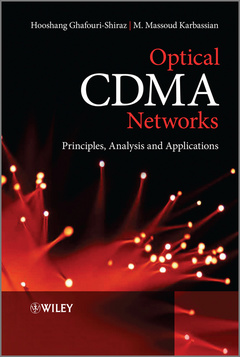Optical CDMA Networks Principles, Analysis and Applications IEEE Press Series
Auteurs : Ghafouri-Shiraz Hooshang, Karbassian M. Massoud

In this book, the authors intimately discuss modern optical networks and their applications in current and emerging communication technologies, evaluating the quality, speed and number of supported services. In particular, principles and fundamentals of optical CDMA techniques from beginner to advanced levels are heavily covered. Furthermore, the authors concentrate on methods and techniques of various encoding and decoding schemes and their structures, as well as analysis of optical CDMA systems with various transceiver models including advanced multi-level incoherent and coherent modulations with the architecture of access/aggregation networks in mind. Moreover, authors examine intriguing topics of optical CDMA networking, compatibility with IP networks, and implementation of optical multi-rate multi-service CDMA networks.
Key features:
- Expanded coverage of optical CDMA networks, starts from principles and fundamentals
- Comprehensive mathematical modelling and analysis from signal to system levels
- Addresses the applications of modern optical networking in the current and emerging communication technologies
- Greater focus on advanced optical multi-level incoherent and coherent modulations, spreading codes, and transceiver designs
- Detailed hardware specifications, system-level block diagrams, and network nodes? functionalities
This book appeals to researchers, practicing engineers, and advanced students. It is a practical resource for readers with an interest in optical communications and networks.
List of Tables xxv
Preface xxvii
Acknowledgements xxxiii
1 Introduction to Optical Communications 1
1.1 Evolution of Lightwave Technology 1
1.2 Laser Technologies 3
1.3 Optical Fibre Communication Systems 4
1.4 Lightwave Technology in Future 7
1.5 Optical Lightwave Spectrum 7
1.6 Optical Fibre Transmission 9
1.7 Multiple Access Techniques 10
1.8 Spread Spectrum Communications Techniques 14
1.9 Motivations for Optical CDMA Communications 21
1.10 Access Networks Challenges 22
1.11 Summary 23
References 24
2 Optical Spreading Codes 29
2.1 Introduction 29
2.2 Bipolar Codes 30
2.3 Unipolar Codes: Optical Orthogonal Codes 37
2.4 Unipolar Codes: Prime Code Families 41
2.5 Codes with Ideal In-Phase Cross-Correlation 62
2.6 Multidimensional Optical Codes 76
2.7 Channel Encoding in OCDMA Systems 84
2.8 Turbo-Coded Optical CDMA 100
2.9 Summary 110
References 111
3 Optical CDMA Review 115
3.1 Introduction 115
3.2 Optical Coding Principles 115
3.3 OCDMA Networking: Users Are Codes 117
3.4 Optical CDMA Techniques 119
3.5 Free-Space and Atmospheric Optical CDMA 126
3.6 Summary 128
References 128
4 Spectrally Encoded OCDMA Networks 133
4.1 Introduction 133
4.2 Spectral-Amplitude-Coding Schemes 134
4.3 System Considerations 141
4.4 Gaussian Approach Analysis 144
4.5 Negative Binomial Approach Analysis 153
4.6 Spectral-Phase-Coding Schemes 164
4.7 Summary 167
References 167
5 Incoherent Temporal OCDMA Networks 171
5.1 Introduction 171
5.2 PPM-OCDMA Signalling 172
5.3 PPM-OCDMA Transceiver Architecture 173
5.4 PPM-OCDMA Performance Analysis 180
5.5 Discussion of Results 183
5.6 Overlapping PPM-OCDMA Signalling 187
5.7 OPPM-OCDMA Transceiver Architecture 188
5.8 OPPM-OCDMA Performance Analysis 196
.9 Discussion of Results 203
5.10 Analysis of Throughput 209
5.11 Summary 211
References 211
6 Coherent Temporal OCDMA Networks 213
6.1 Introduction 213
6.2 Coherent Homodyne BPSK-OCDMA Architecture 214
6.3 Coherent Heterodyne BPSK-OCDMA Architecture 222
6.4 Summary 229
References 230
7 Hybrid Temporal Coherent and Incoherent OCDMA Networks 231
7.1 Introduction 231
7.2 Coherent Transmitter with Incoherent Receiver 232
7.3 Analysis of Transceivers with MAI Cancellation 235
7.4 Results and Throughput Analysis 239
7.5 Summary 244
References 244
8 Optical CDMA with Polarization Modulations 245
8.1 Introduction 245
8.2 Optical Polarization Shift Keying (PolSK) 247
8.3 PolSK-OCDMA Transceiver Architecture 254
8.4 Evaluation of PolSK-OCDMA Transceiver Performance 263
8.5 Transceiver Architecture for Hybrid F-PolSK-OCDMA 265
8.6 Performance of F-PolSK-OCDMA Transceiver 273
8.7 Long-Haul PolSK Transmission 273
8.8 Summary 278
References 278
9 Optical CDMA Networking 281
9.1 Introduction 281
9.2 OCDMA-PON 289
9.3 OCDMA-PON Architecture 290
9.4 IP Traffic over OCDMA Networks 299
9.5 Random Access Protocols 308
9.6 Multi-Protocol Label Switching 330
9.7 Summary 342
References 344
10 Services Differentiation and Quality of Services in Optical CDMA Networks 347
10.1 Introduction 347
10.2 Differentiated Services in Optical CDMA 351
10.3 Variable-Weight Optical Spreading Codes 354
10.4 Variable-Length Optical Spreading Codes 364
10.5 Multirate Differentiated Services in OCDMA Networks 376
10.6 Summary 383
References 384
Index 387
Dr. Massoud Karbassian, University of Birmingham, UK Massoud Karbassian received his Ph.D. degree in optical communications and networks from the University of Birmingham in 2009. He is a researcher in the Optical Devices and Communication Laboratory in the Department of Electronic, Electrical and Computer Engineering, where he has been working on optical CDMA transport networks since 2006. Dr. Karbassian has been recently working extensively on investigating IP-over-OCDMA communications for next generation access networks.
Date de parution : 08-2012
Ouvrage de 432 p.
17.5x25.2 cm
Thème d’Optical CDMA Networks :
Mots-clés :
Optical CDMA Networks; optical communications; optical spreading codes; optical CDMA review; spectrally encoded OCDMA networks; incoherent temporal OCDMA networks; coherent temporal OCDMA networks; hybrid temporal coherent and incoherent OCDMA networks; optical CDMA with polarization modulations; optical CDMA networking
